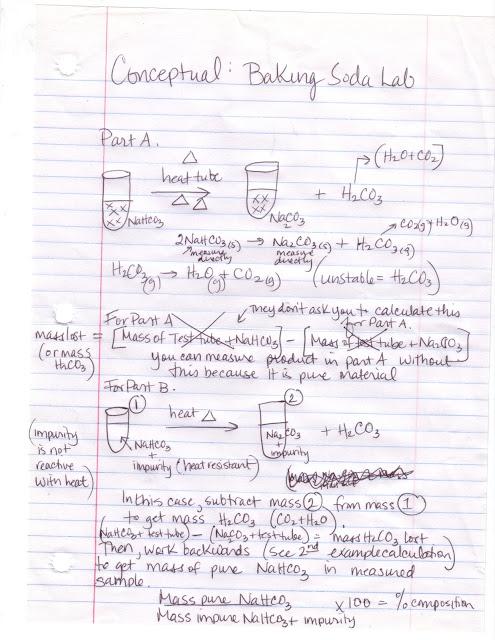 This is a conceptual drawing of the baking soda lab. I love this lab because it asks the students to really think about the concept of molar quantities. In Part A they measure out an amount of baking soda (NaHCO3)[I can't seem to make subscripts in Blogger].Then, they convert to product using molar ratios/molar masses. Measuring the exact mass lost in the reaction is irrelevant in this case, because they can measure the pure starting material and convert directly to moles (with molar mass).
This is a conceptual drawing of the baking soda lab. I love this lab because it asks the students to really think about the concept of molar quantities. In Part A they measure out an amount of baking soda (NaHCO3)[I can't seem to make subscripts in Blogger].Then, they convert to product using molar ratios/molar masses. Measuring the exact mass lost in the reaction is irrelevant in this case, because they can measure the pure starting material and convert directly to moles (with molar mass).In Part B they are unable to measure starting material and convert to moles because the starting material is contaminated with an impurity. The impurity is heat-resistant and unaffected in the experiment. In this section, they must use the law of conservation of mass to figure out how much H2CO3 was lost in the reaction. It is only by subtracting the mass of the (product + test tube) from the mass of (starting material + test tube) that they can find the mass of the H2CO3 produced in the reaction. (H2CO3 is unstable and dissipates as H2O and CO2). From the mass lost, they can find moles of carbonic acid (with molar mass) and then use molar ratios to find the mass of baking soda in the original material. They are asked to calculate percent composition of the mixture. From their original mass they have the denominator of their equation. The pure material is found with the mass of carbonic acid and molar ratios. They divide pure baking soda by the impure mixture and multiply by 100 to get their percentage.
From my perspective this seems to be a straightforward lab. But- if you aren't used to using balanced equations and molar ratios it is a challenge to visualize it. Hopefully this picture helps students understand what is going on in the experiment.
